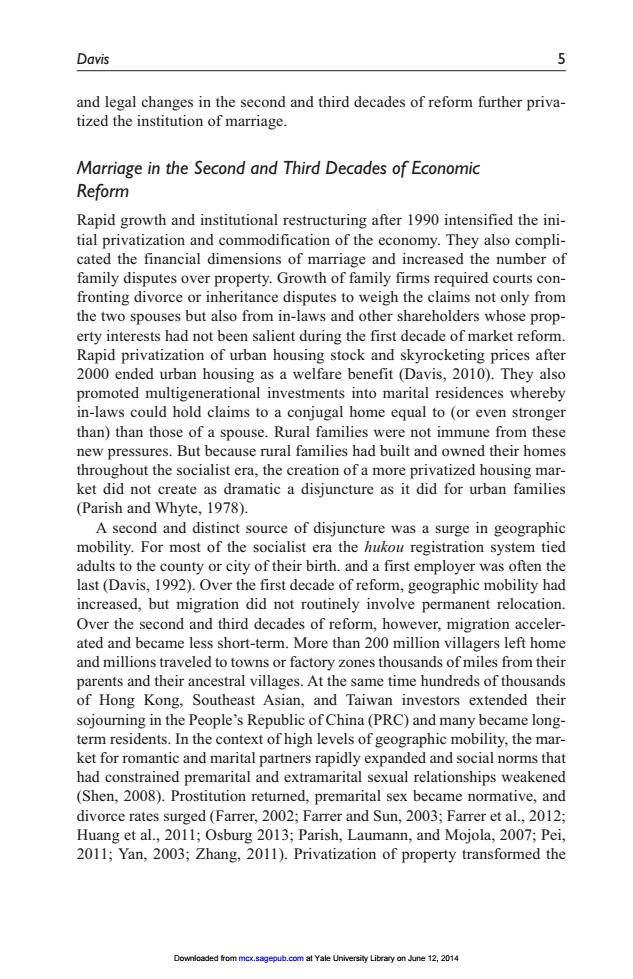正在加载图片...

Davis 5 and legal changes in the second and third decades of reform further priva- tized the institution of marriage. Marriage in the Second and Third Decades of Economic Reform Rapid growth and institutional restructuring after 1990 intensified the ini- tial privatization and commodification of the economy.They also compli- cated the financial dimensions of marriage and increased the number of family disputes over property.Growth of family firms required courts con- fronting divorce or inheritance disputes to weigh the claims not only from the two spouses but also from in-laws and other shareholders whose prop- erty interests had not been salient during the first decade of market reform. Rapid privatization of urban housing stock and skyrocketing prices after 2000 ended urban housing as a welfare benefit (Davis,2010).They also promoted multigenerational investments into marital residences whereby in-laws could hold claims to a conjugal home equal to (or even stronger than)than those of a spouse.Rural families were not immune from these new pressures.But because rural families had built and owned their homes throughout the socialist era,the creation of a more privatized housing mar- ket did not create as dramatic a disjuncture as it did for urban families (Parish and Whyte,1978). A second and distinct source of disjuncture was a surge in geographic mobility.For most of the socialist era the hukou registration system tied adults to the county or city of their birth.and a first employer was often the last(Davis,1992).Over the first decade of reform,geographic mobility had increased,but migration did not routinely involve permanent relocation. Over the second and third decades of reform,however,migration acceler- ated and became less short-term.More than 200 million villagers left home and millions traveled to towns or factory zones thousands of miles from their parents and their ancestral villages.At the same time hundreds of thousands of Hong Kong,Southeast Asian,and Taiwan investors extended their sojourning in the People's Republic of China(PRC)and many became long- term residents.In the context of high levels of geographic mobility,the mar- ket for romantic and marital partners rapidly expanded and social norms that had constrained premarital and extramarital sexual relationships weakened (Shen,2008).Prostitution returned,premarital sex became normative,and divorce rates surged(Farrer,2002;Farrer and Sun,2003;Farrer et al.,2012; Huang et al.,2011;Osburg 2013;Parish,Laumann,and Mojola,2007;Pei, 2011;Yan,2003;Zhang,2011).Privatization of property transformed the Downloaded from mcx.sagepub.com at Yale University Library on June 12,2014Davis 5 and legal changes in the second and third decades of reform further privatized the institution of marriage. Marriage in the Second and Third Decades of Economic Reform Rapid growth and institutional restructuring after 1990 intensified the initial privatization and commodification of the economy. They also complicated the financial dimensions of marriage and increased the number of family disputes over property. Growth of family firms required courts confronting divorce or inheritance disputes to weigh the claims not only from the two spouses but also from in-laws and other shareholders whose property interests had not been salient during the first decade of market reform. Rapid privatization of urban housing stock and skyrocketing prices after 2000 ended urban housing as a welfare benefit (Davis, 2010). They also promoted multigenerational investments into marital residences whereby in-laws could hold claims to a conjugal home equal to (or even stronger than) than those of a spouse. Rural families were not immune from these new pressures. But because rural families had built and owned their homes throughout the socialist era, the creation of a more privatized housing market did not create as dramatic a disjuncture as it did for urban families (Parish and Whyte, 1978). A second and distinct source of disjuncture was a surge in geographic mobility. For most of the socialist era the hukou registration system tied adults to the county or city of their birth. and a first employer was often the last (Davis, 1992). Over the first decade of reform, geographic mobility had increased, but migration did not routinely involve permanent relocation. Over the second and third decades of reform, however, migration accelerated and became less short-term. More than 200 million villagers left home and millions traveled to towns or factory zones thousands of miles from their parents and their ancestral villages. At the same time hundreds of thousands of Hong Kong, Southeast Asian, and Taiwan investors extended their sojourning in the People’s Republic of China (PRC) and many became longterm residents. In the context of high levels of geographic mobility, the market for romantic and marital partners rapidly expanded and social norms that had constrained premarital and extramarital sexual relationships weakened (Shen, 2008). Prostitution returned, premarital sex became normative, and divorce rates surged (Farrer, 2002; Farrer and Sun, 2003; Farrer et al., 2012; Huang et al., 2011; Osburg 2013; Parish, Laumann, and Mojola, 2007; Pei, 2011; Yan, 2003; Zhang, 2011). Privatization of property transformed the Downloaded from mcx.sagepub.com at Yale University Library on June 12, 2014